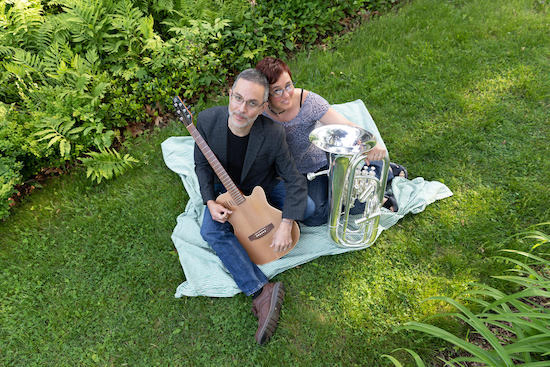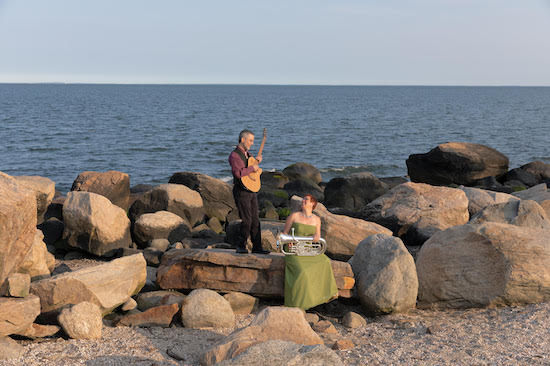
Prof. Baerman and Prof. TenEyck as their “Premier Guitar and Euphonium Duo, Stankeye Jones and the Vagabond Librarians” c/o Claire Femano
Did you know professors can fall in love, too? This year, The Argus talked to professors at the University who are together to hear their stories of academia, romance, and everything in between.
Kate TenEyck is an art studio technician and an adjunct assistant professor of art. Noah Baerman is the jazz ensemble director and a visiting assistant professor in Continuing Studies.
The Argus: How did you two meet?
Kate TenEyck: We were both in the [Connecticut] All-State Jazz Ensemble.
Noah Baerman: In 1992.
KT: I played the trumpet.
NB: We were seniors in high school.
KT: [All State] has these very ambitious students, and they throw them together for a weekend, and they perform.
NB: Kate was a really accomplished trumpet player, so she could have been in the orchestra or jazz ensemble. I, meanwhile, came in second, but the person who came in first had another gig, so they gave it to me—thanks, universe.
A: What do you remember of that weekend?
NB: I remember that weekend well, and I remember that [her] conversations had a level of wit that I was not accustomed to.
KT: And I thought he was cute and talented.
NB: And I thought she was cute and talented. And then we were friends for four years.
A: How did you stay in touch?
NB: Oh, stone tablets, carrier pigeons. We would write letters. Occasionally we would indulge in an expensive long-distance phone call.
A: Now at Wesleyan, is this the first time you two have worked at the same institution?
NB: The first time was sort of Wesleyan-adjacent. There was a program called the Center for Creative Youth (CCY), which is relevant to our story in a couple of ways. One, that was the first context [where] we taught together. It was a summer residential arts program for high school students that happened 40+ years on the Wesleyan campus and was a COVID casualty. And then, a couple of years after we were both teaching there, it was also the beginning of the next phase of our journey as a married couple. We have three kids who were all adopted as teenagers out of the foster care system. And the first and oldest of those was a student at CCY in Kate’s art class.
KT: That’s a whole story!
NB: We knew we wanted to parent, and we were not, for various reasons, interested in procreating, so we decided that we would look into adopting. We were looking at adoption and not foster care, because we didn’t want to have to attach and then separate. Rebecca was Kate’s student in this summer program [in 2004], and we found out that she had nowhere to go when it was over. And so…do you want to take it from there?
KT: Well, I invited her to live with us without asking Noah.
NB: This typifies much of how we live, not not communicating about important things, but actually quite the contrary: communicating a lot about important things, such that when a moment that requires swift decision-making occurs, we’re not speculating. Some of the most important split-second decisions we’ve made have been fairly straightforward because we know who we’re trying to be, and what life we’re trying to cultivate.

c/o Claire Femano
KT: Before I came to Wesleyan, I worked for OddFellows Playhouse, and so I was working with a lot of at-risk youth, a lot of kids who are one step removed from foster care. And I just felt like these kids had so much to offer. And once-a-week arts programming wasn’t going to do it. You know, they really needed someone to make sure that they’re eating meals, that they’re getting to school, that they’re feeling loved. So, when I left OddFellows to work here, I was like, “Okay, I want to continue working with kids who really need help, but let’s do it this way instead.”
NB: And so then [in 2006, the foster system] matched Ariana with us, and then, a year later, her biological sister Tiana. I was in a recording session, and I [had] turned off my phone to make a record; I finished tracking the record and turned my phone back on, and there was a message [from TenEyck] “Call me as soon as you get this.” That was 2007, and now [Tiana’s] 32, and I will be walking her down the aisle for a wedding at Indian Hill Chapel in two months.
A: What’s been the effect of working at the same institution on your marriage?
NB: I don’t want to sound boastful or anything, but we really enjoy each other’s company. Any context in which we can be around each other more is nice. We derive nourishment from just being in tune on a regular basis. Ariana tells this story of her high school friends being bewildered that we didn’t have a television. Like, “What do they do?” We cook together, we talk.
A: In addition to domestic collaboration, I know you two have collaborated artistically.
NB: The most recent is Stankeye Jones and the Vagabond Librarians—which is the greatest euphonium guitar folk blues duo in central Connecticut. I don’t usually brag.
KT: I continued to play the trumpet off and on over the years, but I got kind of tired of it. So I decided to play the euphonium, which has the same fingerings as the trumpet, and you can play bass lines on the euphonium. Noah would sing and play guitar because he also writes.
A: I’m curious if you have a Middletown social world, or if it’s mostly Wesleyan-related.
NB: It’s a great community in Middletown. We find Middletown, pound for pound, to be a really hip place. And our biggest problem socially is we just don’t have a lot of time to socialize. The cool people here exponentially exceed the time we have to have dinner parties.
This interview has been edited for length and clarity.
Arya Dansinghani can be reached at adansinghani@wesleyan.edu.
Nancy Li can be reached at nli02@wesleyan.edu.
Thomas Lyons can be reached at tlyons@wesleyan.edu.
Lyah Muktavaram can be reached at lmuktavaram@wesleyan.edu.
Janhavi Munde can be reached at jmunde@wesleyan.edu.